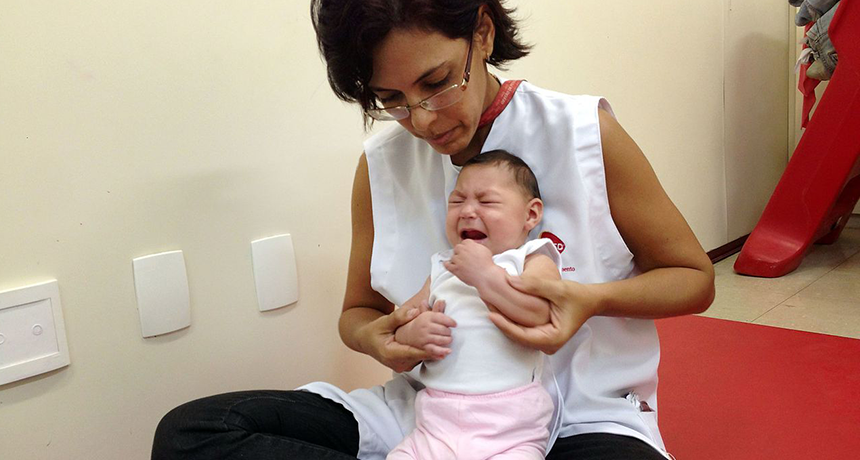Small genetic accident made Zika more dangerous
Newfound mutation in the virus enhanced its ability to spread and to damage a baby’s brain

A genetic mutation in the Zika virus occurred in 2013, a study finds. It boosted the ability of this virus to damage nerve cells in developing brains. That may help explain a relatively recent surge in birth defects after pregnant women became infected.
Sumaia Villela/Agência Brasil/Wikimedia Commons (CC BY 3.0 BR)
A single genetic change — or mutation — made the Zika virus far more dangerous, a new study suggests. That change upped the ability of the virus to kill nerve cells in the brain of a developing baby.
The mutation changed just one amino acid in a protein that the gene instructs a cell to make. That altered protein helps the Zika virus kill brain cells more easily. It also may increase the risk of a birth defect called microcephaly (My-kroh-SEFF-uh-lee). Babies born with this condition have heads and brains that are abnormally small.
Researchers reported their new results September 28 in Science.
Those scientists calculated that the mutation arose around May 2013. This was shortly before a Zika outbreak in French Polynesia. That’s a nation of islands in the South Pacific.
Mosquitoes spread the virus, which was discovered decades ago. But Zika wasn’t linked to high rates of microcephaly until a Brazil outbreak in 2015 and 2016. That’s when high numbers of women infected with Zika started giving birth to babies with small heads.
Researchers weren’t sure why Zika suddenly seemed to cause this birth defect, says Pei-Yong Shi. He is a virologist at the University of Texas Medical Branch at Galveston. Researchers have considered several possibilities. Maybe the virus caused microcephaly before, but no one noticed. Perhaps the immune systems of people in South America just didn’t know how to fight it. Maybe they had a higher genetic risk. Or perhaps some earlier infection with a different virus somehow made Zika worse.
Shi and a team in China had a different idea. They thought a change in the virus itself might be responsible for the birth defect.
Strains are microbes that belong to the same species but differ slightly in their genes and behaviors. The researchers compared a strain of Zika that came from a patient in Cambodia in 2010 to three other strains. Those others came from patients in 2015 or 2016 who had become infected in South America (Venezuela), on a South Pacific island (Samoa) and on a Caribbean island (Martinique). The team found each of these three strains from the recent epidemic shared seven genetic differences from the Cambodian virus.
Researchers then made seven versions of the Cambodian virus. Each of these lab-made types contained one — and only one — of the different gene versions that had been seen in the epidemic strains. The team then infected the brains of fetal mice with these tweaked versions of the Cambodian strain.
A strain with one of the mutations seen in the epidemic version of the virus killed more brain cells in fetal mice than the earlier, Cambodian strain did. This mutant virus also attacked and killed human brain cells that were grown in lab dishes.
“That’s pretty convincing evidence that [that mutation] at least plays some role in what we’re seeing now,” says Anthony Fauci. He directs the National Institute of Allergy and Infectious Diseases. It’s part of the National Institutes of Health in Bethesda, Md.
The mutation changes an amino acid in a protein that Zika instructs cells to make. That protein is called prM. It helps the virus mature within infected cells. It also helps them get out of those cells to infect others. Shi and colleagues don’t yet know why this protein variant should help the virus kill brain cells, too.
The change in prM probably isn’t the whole reason Zika may cause smaller brains, Shi says. The Cambodian strain also led to the death of a few brain cells. But it may not kill enough to cause the birth defect. Shi and his colleagues believe other changes in the virus exaggerate its risks. In May, for instance, his team described another mutation seen in the epidemic strains. It makes Zika dangerous in a different way. It makes it easier for virus to infect mosquitoes.
Brain cells from different people vary in their susceptibility to Zika infections, says Scott Weaver. He’s an infectious-disease researcher. Although he also works at the University of Texas Medical Branch, he was not part of Shi’s team. Weaver says scientists need to do more work. They should study cells from more people to see how the different versions of virus affect them. The scientists also should probe Zika’s effects in nonhuman primates. If they respond similarly, that might confirm that this mutation is really behind microcephaly.







